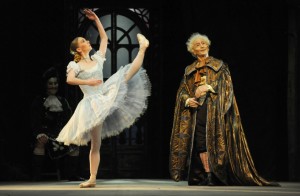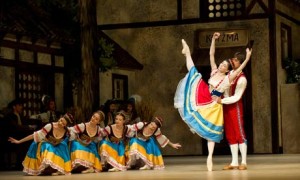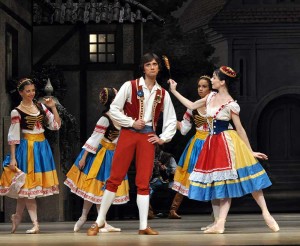Let us reenter the strange world of ballet’s romantic mysticism for one more week before closing with a post on ballet’s changes in the 21st century.
This week’s ballet is Coppélia, a ballet similar to The Nutcracker in some of its basic story elements. First, a doll is a main character; the story is based around a life-size doll that is realistic enough to be mistaken as a real, alive human. Unlike The Nutcracker, the doll never comes to life though (which is probably for the best, as you will see when we get into the full synopsis). The second similarity is the presence of an eccentric inventor who builds this doll, comparable to Drosselmeyer in The Nutcracker, though this one seems more diabolic, more ridiculous, and maybe a little insanely obsessive with his doll creation.

In fact the similarities between the two ballets are not coincidental; both are based on stories by E.T.A. Hoffman. Coppélia is actually a combination of two: The Sandman and The Doll. The comic ballet takes its name from the Greek word for ‘young lady’, hinting at the type of doll that the plot hinges on.
The ballet’s initial success was brought to a tragic halt, since political conflict and war don’t tend to hold back for the sake of art. Premiering in May of 1870 in Paris, Coppélia was soon interrupted by the Franco-Prussian War when Paris was sieged. Its talented young principal ballerina had less than a year to dance the lead role before her death at the age of 17, dying for reasons related to the war.

Enough background information, let’s get to the storyline! The ballet opens with the scene of a town festival celebrating the grain harvest. A young couple, Franz and Swanhilde, are planning to marry during this festival. Overlooking the town square is the balcony of Dr. Coppelius’ house, where a beautiful girl sits, motionless, reading, never distracted by the festivities happening below. Franz takes notice of her, and he dances to catch her attention. Of course Swanhilde is unhappy with her fiancé’s fixation on this strange girl, who never notices him. Following the superstitions of the holiday, she shakes a head of wheat by her ear to hear if it rattles, which supposedly will predict a couple’s marriage at the wheat festival.
In their own ways, Swanhilde and Franz both determine to find more about the girl named Coppélia. Franz climbs a ladder to her balcony; Swanhilde takes the keys to Dr. Coppelius’ house and investigates with her friends while he is gone. Upon entering the house, they discover rooms full of life-size wind-up mechanical dolls he has built. Coppélia is just another of these dolls, except she was created for the special purpose of being Dr. Coppelius’ companion, if he could somehow find a way to bring her to life. For this he needs a human sacrifice. When he returns, he finds the girls snooping around his house and throws them out, though Swanhilde hides behind a curtain. He finds Franz as well, and when he sees Franz’s attraction to Coppélia, he decides to use Franz’s soul to bring Coppélia to life. Swanhilde watches him prepare the spell and dresses up as Coppélia to save Franz. The confusion interrupts the spell and Swanhilde is able to wake Franz and help him escape.
Swanhilde and Franz do get married, although they are almost stopped by Dr. Coppelius’ anger. He demands them to pay for the damage done to his dolls in the mix up, and the mayor ends up paying so that Swanhilde will not have to give up her dowry. The ballet finally closes with the town celebrating the union of the happy couple.
Though magic is central to this ballet like the other Romantic ballets I’ve written about, this one has a truly happy ending. How refreshing.
Sources:
http://en.wikipedia.org/wiki/Copp%C3%A9lia
http://www.shomler.com/dance/coppelia/ct.htm

